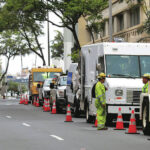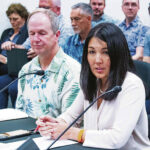Hawaiian Electric system upgrades to buffet electric bills


Future Hawaii electric bills won’t display the cost to ratepayers for more than $1 billion in planned grid resiliency and wildfire mitigation projects, but a bit of this anticipated expense is beginning to emerge.
Hawaii’s largest electric utility, Hawaiian Electric Co., is seeking regulatory approval for a second “exceptional” investment project where it intends to recover costs from ratepayers who stand to have their bills affected by incremental, long-lasting small increases.
ADVERTISING
The company on June 19 filed an application with the state Public Utilities Commission to improve resilience, flexibility, reliability and efficiency of grid systems on Oahu, Maui, Molokai, Lanai and Hawaii island at a cost of $497 million.
Under the plan, 48% of the cost, or $238 million, is being sought from the U.S. Department of Energy under a grant application, which if approved would put the utility company’s share of the project at $259 million and reduce potential costs passed on to customers.
If the federal grant is awarded, the company’s $259 million expense is estimated to increase the average monthly bill for a typical residential customer using 500 kilowatt-hours of electricity by 44 cents on Oahu, $1.97 on Hawaii island and $1.99 in Maui County, according to the filing.
Those estimates represent increases of 0.2%, 0.8% and 1% by region, respectively.
If the grant gets awarded, the company anticipates work will span eight years, starting in July 2025.
New capabilities planned as part of the project include de-energizing broken or downed power lines before they touch the ground, detecting equipment defects that precede a power failure to make repairs before power fails, and sectionalizing more parts of the grid by remote control so that fewer customers are negatively affected by a public safety power shutoff.
Hawaiian Electric is activating its public safety power shutoff program, or PSPS, today.
The PSPS was prompted by the Aug. 8 wildfire on Maui, which killed 102 people and destroyed most of Lahaina, including about 3,500 homes. Hundreds of lawsuits filed by people who suffered losses allege that Hawaiian Electric power lines blown down by gale-force winds started the fire.
Under PSPS, the utility may turn power off in parts of Maui, Hawaii island, Oahu and Molokai during certain conditions that include drought and high wind. About 48,000 of Hawaiian Electric’s roughly 471,000 customers are subject to PSPS, and could go without power for several hours to a few days, depending on conditions.
• • •
Project pipeline
Another exceptional investment project the company is pursuing will harden the electric grid against wind, flooding, fire and other threats.
This project, approved by the PUC in January, is to cost $190 million. Because the federal government has already agreed to pay half, Hawaiian Electric’s $95 million share is estimated to raise a typical residential customer’s monthly bill by 33 cents on Oahu, 71 cents in Maui County and 86 cents on Hawaii island, or between 0.2% and 0.4%.
Work included in this project, projected to span five years, includes strengthening critical transmission lines, hardening circuits serving critical customers, monitoring substations for flood and putting some overhead distribution lines underground.
Hawaiian Electric also is pursuing two other extraordinary projects with possible federal grant contributions under the U.S. Department of Energy’s Grid Resilience and Innovation Partnerships program.
One grid resilience project with a wildfire focus is to cost $200 million, and half could be covered by a federal grant. The other project, which in part involves system management improvements, is to cost $205 million, with $100 million sought from the grant program.
The cost of all four projects totals $1.1 billion, including $545 million potentially paid for by federal grants that would help keep rate increases relatively small.
“We’re trying to get as much federal dollars into the state as we can,” said Shelee Kimura, Hawaiian Electric president and CEO.
The $95 million grant approved to date represents, by far, the biggest federal grant Hawaiian Electric has ever received.
If federal grants don’t come through, ratepayers likely will have to shoulder more project costs, and work could take longer and force Hawaiian Electric to shift spending away from other things.
Typically, the utility spends $300 million to $400 million a year on mostly more ordinary capital improvement projects. Another $400 million or so also is typically spent annually on maintenance and operations, though last year the figure was $533 million.
• • •
Regulatory control
Since 2021, Hawaiian Electric has operated under “performance based regulation” where base rate revenue is fixed and gets adjusted annually for inflation and other factors.
The performance-based setup was estimated to reduce customer rates by about $70 million through 2025, including $12.6 million in 2021 that approximated a savings of $1.27 per month for a typical residential customer, according to the PUC.
This framework replaced what had historically been periodic applications by the company to raise base rates. The last such application that resulted in a rate increase on Oahu was approved in 2011, a 2.2% increase that added $3.31 to a typical residential customer’s monthly bill on the heels of a 5.7% increase in 2010 that added $7.82 to the same typical bill.
Such base rate increases used to provide revenue for capital improvement projects. Under current PUC regulations, Hawaiian Electric can apply to recover extraordinary project costs through an “exceptional project recovery mechanism.”
This year, Hawaiian Electric expects to spend about $115 million on wildfire mitigation funded from its existing budget for capital improvements and operations.
The company also intends to file a wildfire safety plan for 2025 through 2027 with the PUC by the end of the year, which Kimura said will involve a request to recover some costs from ratepayers.
A total cost for this plan has not been estimated, though parts will include some things covered by projects with approved or pending federal grant funding.
“We’re still determining what the long-term wildfire safety plan would include and what it may cost,” Jim Kelly, Hawaiian Electric vice president of government and community relations, said in an email.
It will be up to the PUC to determine an appropriate amount of exceptional project costs passed on to ratepayers, based in part on input from the company, the state consumer advocate and other stakeholders.
“We may never get recovery for some of the work we’re doing,” Kimura said.
Kimura added that Hawaiian Electric continually weighs system investments with costs to ratepayers. “We are very cognizant of affordability of rates,” she said.
One current drag on the company’s ability to manage affordability is its credit rating, which after Aug. 8 got slashed from investment to junk grade because of the wildfire litigation. The bad credit rating makes financing projects using debt more expensive.
An effort to address this issue by having state lawmakers allow Hawaiian Electric to sell low-interest bonds secured by ratepayer revenue subject to PUC approval failed earlier this year. The company, which has said such securitized bond financing could save ratepayers $33 million a year for 30 years, intends to try again next year to have such legislation passed.
Meanwhile, the PUC on Thursday approved a $250 million Hawaiian Electric line of credit from several banks secured by revenue from substantially all ratepayers.
• • •
Fuel factor
Beyond borrowing costs and exceptional investment projects, one thing has a far greater impact on the cost of electricity for Hawaii ratepayers. It is the cost of fuel, which represents about half of a typical residential customer’s bill.
A heavy reliance on imported oil to generate most power for Hawaiian Electric grids on five islands is the primary reason why the state’s average electricity cost to residential customers is nearly triple the national average.
Fluctuations in the price of oil translate to increases or decreases in monthly bills.
A gradual shift to replace oil with renewable energy, such as wind and solar, with fixed long-term pricing also impacts customer bills.
Generally, renewable energy has been cheaper than oil. But a big expense for battery storage is offsetting some of the savings as more solar farms get added to the grid. For instance, a 42-megawatt solar farm with battery storage that went into service June 7 in Ewa Beach is expected to cost the average residential customer 27 cents more per month.
In an effort to possibly provide ratepayers with substantial relief, Gov. Josh Green recently instructed the Hawaii State Energy Office to study whether liquefied natural gas, which is cheaper than oil, could become a temporary substitute for oil before a complete shift is made to renewable sources.






